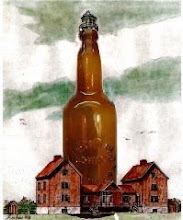Sunday, February 3, 2013
Make a stir starter
Increasing yeast volume is a good reason for growing a yeast starter. Although your yeast volume will increase dramatically, the main reason for growing a starter is so that you can pitch actively growing yeast into your wort and have active fermentation quickly. There are many advantages for making a yeast starter, your wort will begin fermenting much quicker, thus leaving less chance for infection. You will also find that you produce a cleaner, higher quality product. That all being said, here is an inexpensive way to make a stir starter that will aid in yeast growth.
DO NOT WORK ON LIVE CIRCUITS. Your power supply should not be plugged in until you have completed the construction of this SPECIFIC build CORRECTLY. Electricity can kill, regardless of the voltage applied.
All in all parts should cost about $20.
-I used a 6 volt Cell Phone charger as my power supply. Just about any one should work in the 5-12 volt DC range. (They are all DC current)
-4 inch computer fan. (12 volts DC for example)
-Hard drive magnets. You can also buy rare earth magnets online from a number of vendors. Neodymium magnets are cheap retail if you can't find an old hard drive to scrap.
- 2 inch diameter steel washer.
- Some scrap wire will be helpful, however we'll only need about a foot of black and red wire.
The following items are from Radio Shack:
7" x 5" x 3" Project Enclosure: Part Number 270-1807
25 ohm 3 watt Rheostat (aka Potentiometer): Part number 271-265
12 Volt DC/30Amp Rocker Switch with LED - Part Number 275-018
Silver Tone Knob - Part Number 274-424
If you aren't soldering savy, you'll also need to buy:
1/4" Fully Insulated Quick Disconnects (10-Pack) - Part Number 64-4040
Bolts and nuts from the hardware store are (4) 2.5 inch 10/32 bolts), 12 10/32 nuts, and 4 washers to fit the 10/32 bolts.
The most important part of all of this is using the steel washer. By gluing the washer to the fan, you are adding magnetic point for your magnet to stick to without gluing it. This will allow you to fine tune the plate before gluing down your magnet (They won't come off very easily once glued) Also, if you decide that you want to use a larger or smaller stir bar, you can add or remove magnets and center them correctly without having to scrap your fan.
Drill holes and mount the potentiometer. Mount them up using the enclosed hardware that came with both of them. Also drill a hole on the bottom corner of the enclosure to run the power supply out of the box.
Wiring-
Get your Black and Red computer fan wires stripped. If you aren't soldering, put a female quick disconnect onto the Red wire.
Next, cut off the power supply “phone” side and try to keep the power cord going to the wall socket as long as possible in case you make a mistake. Some phone chargers will have two wires, while others I've found have a “braid” going around another insulated wire. The “braid” is our ground or negative and the inner cable is your power side. For the chargers with 2 single wires inside, black is your ground.
Strip about 1/4” of the insulation off your wires. Take the black cable of your computer fan and the black cable of your power supply and twist the exposed wire together and insert them into one of the female quick disconnects. Make sure that you feed your power supply cable through the hole you drilled in your enclosure before crimping or you won't be able to close your box when you are done. Connect these two wires to the “Earth” male connector on your power supply.
Now, take the Red cable from your power supply and add a female disconnect onto this cable and attach it to the “male” terminal on your power switch labeled “Supply”
The only male terminal left on our power switch is the one labeled “Load”. Take some of the spare wire, about 4-5 inches, and strip off the insulation from each end. Attach a female disconnect to each end. Now, attach one side of the wire onto the “Load” terminal on your power switch, and the other to the center pin of the potentiometer.
The last step is to take the “Power” cable (red) from your computer fan and attach another female disconnect. Attach this disconnect onto the right side pin on the potentiometer.
After completing the previous steps you are now ready to plug in your power supply, flip your power switch to the “On” position, and try turning the knob on the potentiometer back and forth. You should be able to observe the fan speeding up and slowing down as you turn the knob back and forth.
Now glue the steel washer onto the fan. I used some 60 second epoxy so that I could turn the fan on and off to observe if the washer was centered on the center of the fan.
The next steps in this project is to fine tune the positioning of the fan within the enclosure, and try magnet combinations and positions until you get your bar spinning correctly.
I used 2 ½ inch #10-32 bolts with matching nuts and washers to mount my fan. I also used some ¾ inch stand offs to raise the fan.
Subscribe to:
Post Comments (Atom)







No comments:
Post a Comment